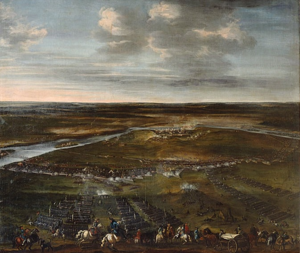Battle of Narva (1700)
| Battle of Narva | |||||||
|---|---|---|---|---|---|---|---|
| Part of the Great Northern War | |||||||
 "Battle of Narva 1700" by Daniel Stawert |
|||||||
|
|||||||
| Belligerents | |||||||
|
|
|
||||||
| Commanders and leaders | |||||||
|
Charles XII Carl Gustav Rehnskiöld Otto Vellingk |
Charles Eugène de Croÿ Avtonom Golovin Ivan Trubetskoy Adam Veyde Boris Sheremetev Alexander of Imereti |
||||||
| Strength | |||||||
|
Narva garrison: 1,800 men, 297 artillery pieces Relief force: 10,500 men, 37 cannons |
37,000 men, 195 artillery pieces |
||||||
| Casualties and losses | |||||||
| 667 killed, 1,247 wounded |
more than 9,000 killed, 20,000 captured |
||||||
|
Notes
|
|||||||
The Battle of Narva (Russian: Битва на Нарве; Swedish: Slaget vid Narva) on 19 November 1700 (30 November, N.S.) was an early battle in the Great Northern War. A Swedish relief army under Charles XII of Sweden defeated a Russian siege force three to four times its size. Before, Charles XII had forced Denmark-Norway to sign the Treaty of Travendal. Narva was not followed by further advances of the Swedish army into Russia; instead, Charles XII turned southward to expel August the Strong from Livonia and Poland-Lithuania. Tsar Peter the Great of Russia took Narva in a second battle in 1704.
During the 17th century, Russia was less advanced technologically than the rest of Europe, a condition which extended to its armed forces. Despite this shortcoming, Peter the Great of Russia was keen to expand his territory by conquering parts of Sweden's Baltic provinces. Russia made a military alliance with Frederick IV, King of Denmark-Norway; and August the Strong, King of Poland-Lithuania and elector of Saxony, to wage war against Sweden. Whereupon all five countries attacked Sweden from several directions.
...
Wikipedia
